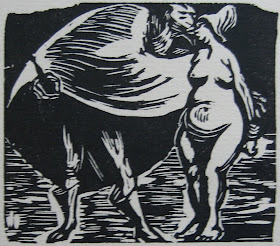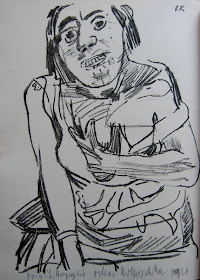There’s currently a fascinating-sounding show at the Frye Museum, Seattle, The Munich Secession and America. As I can’t make it to that (and haven’t as yet got hold of the catalogue), I thought I’d mount my own little exhibition of prints by artists associated with the Munich Secession and the Berlin Secession that grew out of it in 1898.
I’ll start with one of the central figures of the movement, Franz von Stuck (1863-1928). I have two etchings by Franz Stuck (as he then was, the von came when he was ennobled in 1905). Both are after his own paintings, Fighting Fauns (1889) and Lucifer (1889/90). In date they just precede the founding of the Secession, but in spirit they are exactly the kind of art the word Secession evokes. Lucifer, especially, is a wonderfully powerful piece of work. Apparently when people first saw the painting, they crossed themselves to avert its baleful glare. Even in the etching the proud eyes of the fallen angel really shine from the paper, while his winged figure has a monumental weight and dignity. The rebel angel was, I suppose, a fitting icon for the artistic rebels of the Secession.

Franz von Stuck
Lucifer
Etching, c.1890
Franz von Stuck was born in Tettenweis in Bavaria, the son of a miller. He studied at the Kunstgewerbe Schule (School of Decorative Arts) from 1878-1881, and then at the Academy of Fine Art in Munich from 1882-1884. He was subsequently a professor at the Academy, numbering Wassily Kandinsky, Paul Klee, and Josef Albers among his pupils. In his day he was immensely influential and highly regarded; for instance Egon Schiele practically worshipped him. His essentially Symbolist art is powerfully infused with that heady fin-de-siècle mix of decadence, sin, eroticism, and existential conflict. His home, the Villa Stuck in Prinzregentstrasse, which in true Jugenstyl manner Stuck designed himself, from the architecture right down to the furniture, the interior decor, and the fixtures and fittings, is now a museum.

Franz von Stuck
Kämpfende Faune
Etching, 1889
Having been overlooked for decades, the art of Franz von Stuck - inspired in its mythological themes by that of Arnold Böcklin - was rediscovered at a retrospective exhibition at the Van Gogh Museum, Amsterdam, in 1995. A second important exhibition, Franz von Stuck: A modern Lucifer, was held at the Museo di arte moderna e contemporanea di Trento e Rovereto in 2006-7.
Alongside the Symbolist art of Franz von Stuck, the Frye Museum show is also concentrating on the work of Fritz von Uhde (1848-1911). Fritz Karl Herman von Uhde was born in Wolkenburg, and studied in Munich. Influenced by French artists such as Michel Cazin and Léon Lhermitte, his work straddles the gap between Realism and Impressionism.

Fritz von Uhde
La petite Emilie
Drypoint after von Uhde by Françoise-Marie Borrel, 1889
Quite a few of the major figures of the Munich Secession were developing a kind of German Impressionism. At the forefront were Max Liebermann (1847-1935) and Leopold von Kalckreuth (1858-1928). The son of a wealthy Jewish businessman from Berlin, Max Liebermann is credited with introducing Impressionism into Germany both as an artist and as a collector. Liebermann is regarded by many as the leading German Impressionist. After the Nazis came to power they seized and destroyed many of Max Liebermann's works from museums and private collections. He is perhaps best remembered today for his etchings, although a 2006 exhibition of his paintings, Max Liebermann: From Realism to Impressionism, at the Skirball Cultural Center, Los Angeles, and the Jewish Museum, New York, helped to bring this important aspect of his work to renewed prominence.

Max Liebermann
La soupe
Etching, 1901

Max Liebermann
Amsterdamme Judengasse
Etching, 1908

Max Liebermann
Eislauf
Etching, 1923
Leopold Karl Walter, Graf von Kalckreuth, was a painter and printmaker strongly influenced by the Impressionists. Kalckreuth was one of the founders of the Secession. Leopold von Kalckreuth was the son of the landscape artist Stanislas de Kalckreuth. He studied at the Munich Akademie, and subsequently taught at the academies of Weimar, Karlsruhe, and Stuttgart. Kalckreuth was influenced by the art of Millet. He was a close associate of Max Liebermann in the introduction of Impressionist ideas and the Impressionist aesthetic into German art.

Leopold von Kalckreuth
Wagen auf der Dorfstrasse
Etching, 1921
I don’t know if Peter von Halm (1858-1923) exhibited with the Secession. As professor of etching at the Munich Academy of Fine Art, he was a colleague of von Struck, and the landscape etchings I possess certainly show the influence of Liebermann. I also have a wonderful etched portrait of von Halm by his close friend Karl Stauffer-Bern (1857-1891).

Peter von Halm
Motiv vom Bodensee
Etching, c.1892

Peter von Halm
Motiv aus Nussdorf am Bodensee
Etching, c.1892

Karl Stauffer-Bern
Peter Halm
Etching,1887
The Berlin Secession, of which Max Liebermann was the first President, was organized on a rather more business-like footing than the Munich Secession, as it had the art dealer and publisher Paul Cassirer as its business manager. While there is still a strong element of Impressionism in the work of an artists such as Paul Baum (1859-1932), it is in the Berlin Secession that Expressionism really emerges as the new German aesthetic, under the guidance of Cassirer, in the work of artists such as Ernst Barlach (1870-1938).
Paul Baum was born at Meissen. He studied at the Academy in Dresden, then in the atelier of the landscape painter Friedrich Peller, and then under Theodor Hagen in the Weimer School of Art. Baum exhibited from 1880. The art of Paul Baum shows the influence of post-Impressionism, especially Pointillism, in its technique and approach.

Paul Baum
Aus Sluis
Etching, 1908
Ernst Barlach was born in Wedel in Holstein. He studied at the School of Arts and Crafts in Hamburg, and then entered the Dresden Academy, where he studied under Robert Dietz. Ernst Barlach then spent a year in Paris at the Académie Julian, discovering the art of Millet, Meunier, and Vincent van Gogh. In 1936, after the Nazis condemned his work as degenerate, the Vienna Secession appointed Ernst Barlach an honorary member. Many of Ernst Barlach's sculptures were destroyed by the Nazis. I’ve posted my Barlach woodcut before, in my post on Degenerate Art, but it seems worth including again here.

Ernst Barlach
Aus de Walpurgisnacht
Woodcut, 1923
Hermann Struck (1876-1944) is a key figure in the Berlin Secession, especially in terms of etching, as he taught many other artists, including Max Liebermann and Marc Chagall, how to etch. His book on the art of etching went through several editions, each illustrated with original prints. Hermann Struck was born in Berlin. His birth name was Chaim Aaron ben David, and his Jewish heritage is central to his work. An early Zionist, Hermann Struck settled in what is now Haifa in 1923.

Hermann Struck
Portrait of Marc Chagall
Etching, 1923

Hermann Struck
Alte Jude aus Jaffa
Etching, 1908
Quite a few like-minded artists from other countries were invited to join the various Secessions. One such member of the Berlin Secession was the leading Norwegian Expressionist, Edvard Munch (1863-1944). His "The Scream" is one of the most famous paintings in the world; it expresses the sense of anxiety and instability that tormented him. Edvard Munch said, "Sickness, insanity and death were the angels that surrounded my cradle, and they have followed me throughout my life." My landscape etching dates from 1908; shortly after creating it, Edvard Munch suffered a devastating mental collapse, and its spare, haunted quality and sense of existential despair is reminiscent of the last works of van Gogh.

Edvard Munch
Landschaft
Etching, 1908
Just to round off this post, here’s another image I’ve posted before, by an artist closely associated with both the Vienna and Berlin Secessions, Oskar Kokoschka.

Oskar Kokoschka
Mädchenbildnis
Lithograph, 1920
Once again, it's interesting to see how we take from the past a bit of this and a little of that. There is little that is "decorative" about these works, except perhaps for Von Stuck's imagined Lucifer, but that is what we usually look for from the Secessionists. There's something sinfully attractive about gold leaf, too.
ReplyDeleteVon Uhde's little Emilie is touching in her sobriety. She makes me think of a film I saw recently, though it's not new - Agnes Varda's Le Glaneur et La Glaneuse.
Thank you.
I haven't seen Le Glaneur et La Glaneuse - in fact the films of Varda in general are one of the glaring gaps in my cultural knowledge, though I've always had an inkling I would like them. What von Uhde's painting particularly brings to mind for me is the 1881 painting Pauvre Fauvette by Jules Bastien-Lepage, and various paintings in a similar vein by Bastien-Lepage's most prominent British follower, George Clausen. There's a strikingly similar composition by Clausen, The Stone Pickers, and paintings in the same vein by other "British Impressionists" such as Henry Herbert La Thangue and James Guthrie.
ReplyDeleteHow strange...I thought of Jules Bastien-Lepage, too, but then wondered if it was because the fortunate children of wealthy countries don't look so serious today. Without art, it would be harder to connect with the past.
ReplyDeleteIt's interesting how the berlin secession mirrors what was happening at the same time on the literary scene, the same mixture of 'ism-en' as they say in german, different litterary trends that have little in common except the rebellion against realism and the fin-de-siecle mood. the 'Lucifer' is really stunning. and again, I would like to photograph such fields as the motifs from bodensee!
ReplyDeleteRecently acquired a pencil signed etching by Franz von Stuck 'Fighting Fauns' and wish to thank you for your insightful blog and the replies.
ReplyDeleteHi Ross - Lucky you! Enjoy your Fighting Fauns (a very interesting etching, I think), and do come back to this blog.
ReplyDeleteThanx, Located the original painting online, there is so much detail in both pieces. Acquired a small etching a few years ago, pencil signed "C. Demuth" Lokks like Charles Demuth to me, but not sure. Not able to find reference in any book or online. Any thoughts? R.
ReplyDeleteCharles Demuth is the only C. Demuth I know of, so I expect it is by him. I'm not aware of him as an etcher, but he quite likely made some. If it's in the Precisionist/Cubist Realist style then it must be him; otherwise, more sleuthing is needed. I'd send a photo to Anne M. Lampe, the director of the Demuth Museum in Lancaster, Pennsylvania, and see what she thinks.
ReplyDeleteNeil, That would be great. Yes, I would sat Cubist/Realist Style. How do I send you the j-peg? I saw that museum listing and didn't know how to approach them. Ross rblewisnyc@netzero.net (Departing today to DC for the next 4 days)
ReplyDeleteRoss - you can email me if you click on View my complete profile, underneath the bit about me on the blog home page. The museum has a Contact button that would allow you to email them - or there's always the post!
ReplyDeleteLocated a high quality print shop in DC. From Martin Lewis to Pop Hart as well as Antique Maps. Also visited your website, quite a collection, and available for acquisition. R
ReplyDeleteWe have two of his etchings Lucifer and Die Sinnlichkeit.
ReplyDeletehttp://barhammoneyfineart.co.uk
Hi Adrian - two really fine etchings by von Stuck - Die Sinnlichkeit (Sensuality) is a prime piece of Symbolist art.
ReplyDelete